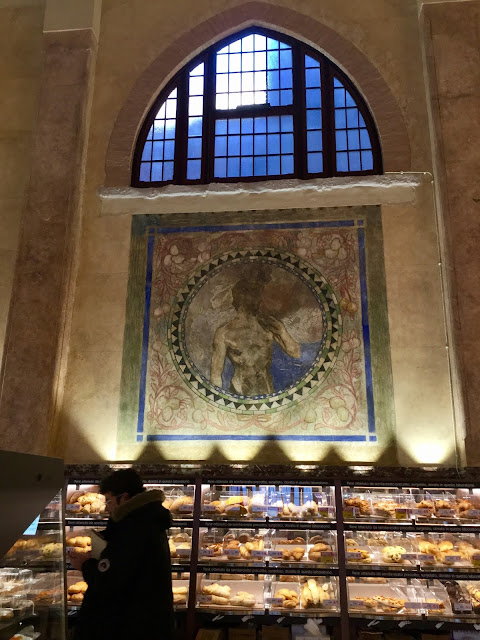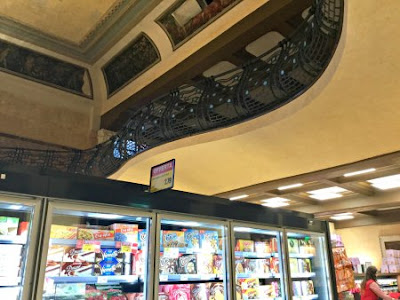 |
Tancredi Parmeggiani in Venice, 1955-56.
Venezia, Fondazione Giorgio Cini, Istituto di Storia dell'Arte, Fondo Cardazzo |
(Venice, Italy) Tancredi Parmeggiani was a beautiful, sensitive soul, both inside and out. I could tell by looking at the works of art he created, and by his striking physical appearance, captured in photos from the 1950s. But most of all, I could tell by speaking to his son, Alexander, who looks uncannily like his father.
 |
Alexander Parmeggiani (center)
with Curator Luca Massimo Barbero
and Peggy Guggenheim Collection Director Philip Rylands
Photo: Cat Bauer
|
Any person whose weapon of choice against the atomic bomb is a blade of grass is in for a difficult time on planet Earth, and Tancredi was no exception. Tancredi was born in Feltre, a hillside town up in Northern Italy in the Veneto province of Belluno, the Dolomites towering in the background.
The family moved to Bologna shortly thereafter; Tancredi's father died when he was 8-years-old; his mother suffered from ill-health; he and his brothers were sent back to Feltre in 1940 under the care of their grandmother and maternal aunt. Tancredi left high school when he was 16-years-old and came to Venice to study art, exchanging the sturdy mountains for the watery lagoon.
 |
| Untitled by Tancredi (Self-portrait) 1948 |
In 1946, in the year of his nineteenth birthday, Tancredi left for Paris and hooked up with the avant-garde. He returned to Italy and lived in both Feltre and Venice, achieving his first solo exhibition at Gallery Sandri in Venice in 1949 at the age of twenty-two. He then moved to Rome, but by 1951, he was back again in Venice, where he met the formidable Peggy Guggenheim, who flipped his world upside down.
 |
Edmondo Bacci, Tancredi Parmeggiani, and
Peggy Guggenheim in the garden of Palazzo
Venier dei Leoni, Venice, early 1950s
Photo courtesy Peggy Guggenheim Collection |
Peggy only put two artists under contract in her lifetime. The first was the American Jackson Pollock, who, on August 18, 1949, had a four-page spread in Life magazine that demanded: "Is he the greatest living painter in the United States?" The second was the Italian, Tancredi Parmegianni, known simply as "Tancredi." Suddenly, Tancredi found himself playing with the major league in the world of art. He was not yet twenty-five.
Tancredi, the boy from Belluno, was given a contract and a small studio in Peggy Guggenheim's palace on the Grand Canal and taken under her wing. Peggy "made it her mission that he would achieve international acclaim." We can only imagine how dizzy the artist with a sensitive soul and a love of nature felt when he began his meteoric ascent to fame, sucked into Peggy's tumultuous world.
 |
| Primavera (Springtime) by Tancredi (1951/dated 1952) |
From the exhibition:
"In 1951 I completed a painting called Springtime," wrote Tancredi in 1962, "which has been at the Museum of Modern Art in New York since 1952. It is an 'abstract universal landscape' painted with three small dots and dabs of the brush in a manner that makes one think of flowery fields, sky and earth."
 |
| Springtime (section) Photo: Cat Bauer |
According to the
Guggenheim website:
Tancredi had solo exhibitions at the Galleria del Cavallino, Venice
(1952, 1953, 1956, 1959), and at the Galleria del Naviglio, Milan
(1953). He participated in Tendances actuelles (Contemporary trends, 1954) with Georges Mathieu, Jackson Pollock,
Wols (Alfred Otto Wolfgang Schulze), and others at the Kunsthalle Bern,
Switzerland. His work was included in a 1955 group show at the Galerie
Stadler, Paris, a city he visited that year. In 1958 further solo
presentations of his work were exhibited at the Saidenberg Gallery, New
York, and the Hanover Gallery, London, and he took part in the
Pittsburgh International (now Carnegie International). In 1959 he
settled in Milan, where he showed several times at the Galleria
dell’Ariete. That same year Tancredi traveled again to Paris, and in
1960 he visited Norway. Also in 1960 the painter participated in Anti-Procès
(Anti-process) at the Galleria del Canale, Venice; the gallery gave him
solo shows that year and in 1962. He received the Marzotto Prize in
Valdagno, Italy, in 1962 and exhibited at the Venice Biennale in 1964.
 |
| Alex in front of his father's A Propos of Venice (1958) Photo: Cat Bauer |
As I wandered around the exhibition, I found myself in the same room as Tancredi's son, Alex. Even though Alex was born in Milan in 1963, he grew up in Norway; his mother was the Norwegian painter, Tove Dietrichson, whom Tancredi married in November 1958. I asked Alex how it felt to be surrounded by all his father's paintings. Alex said that he was only one-year-old when his father died, so he never really knew him. But growing up with his artwork and his writings made him feel his father's presence very strongly, and that he was, indeed, a beautiful, sensitive soul, with great intelligence, deeply affected by the condition of the world.
We spoke about how Jackson Pollock and Tancredi were the only two artists under contract to Peggy Guggenheim, and how intense it must have been. I asked Alex how his father had died. "Don't you know?" I shook my head. "He committed suicide." I paused. "I thought so... just by looking at his work..." Then I asked, "...How?" Alex became emotional. "I'm sorry. I can't talk about it. Please do that research on your own." Then I became emotional. "Please forgive me. That was incredibly insensitive of me."
 |
| Untitled from the series 'Country Diaries' (1961) |
I imagined what life must have been for a young, sensitive artist growing up during World War II, especially when the battleground was your home turf. When Tancredi was born in 1927, Italy was a dictatorship under Mussolini. On June 10, 1940, when Italy entered World War II on the side of the Nazi Germany, he was 12-years-old. In 1943, when Tancredi left Feltre for Venice, the Allies invaded Italy in the South; Italy switched sides, and Germany invaded Italy in the North.
On March 21, 1945, the British bombed the Nazi ships in the Venice lagoon during "Operation Bowler." Some clever person named "Wimpy" has overlaid the bombing on a Google map:
On April 29, 1945, the Allies liberated Venice -- or so the story goes -- and soldiers flooded into the city, riding on gondolas and feeding pigeons in Piazza San Marco, celebrating up a storm. On May 8, 1945, V-Day, Germany surrendered to the Allies, something Japan refused to do.
On August 6, 1945, the US dropped the atomic bomb with the adorable name of "Little Boy" on Hiroshima, and then, to show they were not joking, they dropped "Fat Man" on Nagasaki on August 9th. On September 2, 1945, Japan signed the instrument of surrender, and World War II was over. More than 60 million people had died; the figure rises to more than 80 million if you include disease and famine caused by the war, 50-55 million of them civilians. That is a lot of death and destruction for any human being to assimilate, let alone a sensitive young artist.
 |
| Hiroshima Atom Bomb |
Then, almost immediately, around 1947 the Cold War began. With Nazi Germany gone, the two super powers, the United States and the Soviet Union, allied during World War II but ideologically opposed, became bitter enemies. By the time the 1960s rolled around, bomb shelters in backyards became all the rage, and the planet nearly annihilated itself during the Cuban Missile Crisis.
 |
| Untitled by Tancredi (1950-51) |
Tancredi's career began taking off at the start of the Cold War. Post-war Art World Headquarters had moved abruptly from Paris to New York City. At that time, Abstract Expressionism became the first specifically American art movement to achieve international acclaim, with Jackson Pollock the star of the show -- until August 11, 1956 when he spectacularly smashed his car into a tree and decapitated himself.
In 1947, Peggy Guggenheim closed her New York gallery, The Art of This Century, and moved to Venice, where Tancredi would meet her in 1951. Thanks to the influence of the American Peggy Guggenheim, the young Italian Tancredi Parmegianni got up-close and personal with Abstract Expressionism.
 |
| A Propos of the Lagoon by Tancredi (1958) |
Tancredi left his collaboration with Peggy Guggenheim in 1955. Even though he left Venice, Venice remained in his thoughts, and in his work. As the Cold War continued to build, growing ever more perilous, Tancredi became more erratic, which was reflected in his writings and his work. In 1962, he was diagnosed with paranoid schizophrenia, an "illness" that seems to affect many sensitive souls sickened by the dance with annihilation being played out on the world stage. Tancredi fought back with images of nature and gardens, and bright, bold colors.
He also created three works dedicated to Hiroshima.
 |
| Hiroshima 1 by Tancredi (1962) |
From the catalogue:
In the motifs of his last years, Tancredi anticipated the political protest movement: his participation in the militant exhibition Anti-Procès, organized by Jean-Jacques Lebel in 1959, for example, was a stand against hatred and violence. "I hate hatred," he wrote almost in desperation, incapable, with his sensitivity, his love of painting, of confronting a sterile, violent, corrupt, inhuman world.
Looking at his three works dedicated to Hiroshima in 1962, reflections in the early 1960s on violence and human race come to mind, reflections that took an increasingly lapidary form such as "I hate hatred." This is the context for his decision to paint a triptych dedicated to the atom bomb at a time when there was a genuine collective fear of nuclear holocaust.
One cannot fail to recall a short, devastating thought preserved in his notes: "My weapon against the atom bomb is a blade of grass."
On September 27, 1964, two days after his thirty-seventh birthday, Tancredi Parmeggiani threw himself into the Tiber River in Rome and drowned.
 |
| Hiroshima 2 by Tancredi |
It has since become common knowledge that the CIA used Abstract Expressionism as a weapon during the Cold War without the knowledge of the artists. The reason? To promote the non-communist left in order to combat communism.
Here's a link to an article from
The Independent way back in 1995:
Modern Art was a CIA 'Weapon.' "Its agents were placed in the film industry, in publishing
houses, even as travel writers for the celebrated Fodor guides. And, we
now know, it promoted America's anarchic avant-garde movement, Abstract
Expressionism."
In fact, due to the current
Abstract Expression exhibition at the Royal Academy of Arts in London, the issue has become a hot topic once again. Here's an October 4, 2016 piece from the BBC: "
Was Modern Art a Weapon of the CIA?"
 |
| Hiroshima 3 by Tancredi |
Even if the artists were not aware on a conscious level that they were being used, I wonder -- since they were artists, after all, and much more attuned to knowing better than most of humanity when things are askew -- I wonder if they were aware on a subconscious level of the CIA involvement in their work, and if it affected their art -- and even their very lives.
Tancredi got in the face of the bomb and yanked some atoms out from the clusters, capturing their beauty on paper for humanity to behold.
A blade of grass can be a very effective weapon against the atomic bomb, indeed.
My Weapon Against the Atomic Bomb is a Blade of Grass. Tancredi. A Retrospetive. at the Peggy Guggenheim Collection, curated by Luca Massimo Barbero, runs through March 13, 2017
.
All images courtesy of the Peggy Guggenheim Collection unless otherwise noted.
Ciao from Venezia,
Cat Bauer
Venetian Cat - The Venice Blog




































